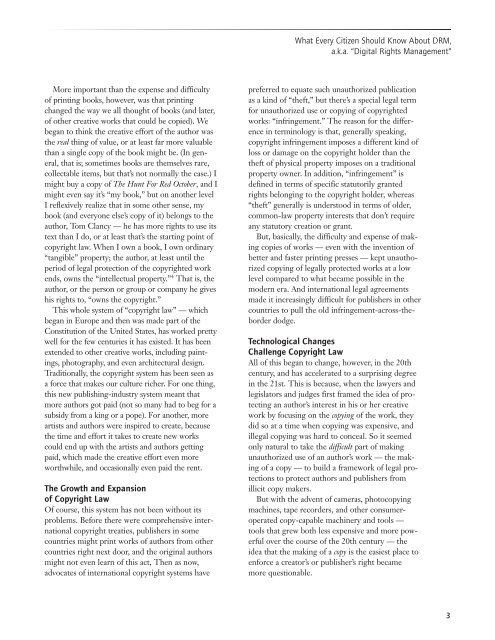What Every Citizen Should Know About DRM, aka - Public Knowledge
What Every Citizen Should Know About DRM, aka - Public Knowledge
What Every Citizen Should Know About DRM, aka - Public Knowledge
Create successful ePaper yourself
Turn your PDF publications into a flip-book with our unique Google optimized e-Paper software.
<strong>What</strong> <strong>Every</strong> <strong>Citizen</strong> <strong>Should</strong> <strong>Know</strong> <strong>About</strong> <strong>DRM</strong>,a.k.a. “Digital Rights Management”More important than the expense and difficultyof printing books, however, was that printingchanged the way we all thought of books (and later,of other creative works that could be copied). Webegan to think the creative effort of the author wasthe real thing of value, or at least far more valuablethan a single copy of the book might be. (In general,that is; sometimes books are themselves rare,collectable items, but that’s not normally the case.) Imight buy a copy of The Hunt For Red October, and Imight even say it’s “my book,” but on another levelI reflexively realize that in some other sense, mybook (and everyone else’s copy of it) belongs to theauthor, Tom Clancy — he has more rights to use itstext than I do, or at least that’s the starting point ofcopyright law. When I own a book, I own ordinary“tangible” property; the author, at least until theperiod of legal protection of the copyrighted workends, owns the “intellectual property.” 4 That is, theauthor, or the person or group or company he giveshis rights to, “owns the copyright.”This whole system of “copyright law” — whichbegan in Europe and then was made part of theConstitution of the United States, has worked prettywell for the few centuries it has existed. It has beenextended to other creative works, including paintings,photography, and even architectural design.Traditionally, the copyright system has been seen asa force that makes our culture richer. For one thing,this new publishing-industry system meant thatmore authors got paid (not so many had to beg for asubsidy from a king or a pope). For another, moreartists and authors were inspired to create, becausethe time and effort it takes to create new workscould end up with the artists and authors gettingpaid, which made the creative effort even moreworthwhile, and occasionally even paid the rent.The Growth and Expansionof Copyright LawOf course, this system has not been without itsproblems. Before there were comprehensive internationalcopyright treaties, publishers in somecountries might print works of authors from othercountries right next door, and the original authorsmight not even learn of this act, Then as now,advocates of international copyright systems havepreferred to equate such unauthorized publicationas a kind of “theft,” but there’s a special legal termfor unauthorized use or copying of copyrightedworks: “infringement.” The reason for the differencein terminology is that, generally speaking,copyright infringement imposes a different kind ofloss or damage on the copyright holder than thetheft of physical property imposes on a traditionalproperty owner. In addition, “infringement” isdefined in terms of specific statutorily grantedrights belonging to the copyright holder, whereas“theft” generally is understood in terms of older,common-law property interests that don’t requireany statutory creation or grant.But, basically, the difficulty and expense of makingcopies of works — even with the invention ofbetter and faster printing presses — kept unauthorizedcopying of legally protected works at a lowlevel compared to what became possible in themodern era. And international legal agreementsmade it increasingly difficult for publishers in othercountries to pull the old infringement-across-theborderdodge.Technological ChangesChallenge Copyright LawAll of this began to change, however, in the 20thcentury, and has accelerated to a surprising degreein the 21st. This is because, when the lawyers andlegislators and judges first framed the idea of protectingan author’s interest in his or her creativework by focusing on the copying of the work, theydid so at a time when copying was expensive, andillegal copying was hard to conceal. So it seemedonly natural to take the difficult part of makingunauthorized use of an author’s work — the makingof a copy — to build a framework of legal protectionsto protect authors and publishers fromillicit copy makers.But with the advent of cameras, photocopyingmachines, tape recorders, and other consumeroperatedcopy-capable machinery and tools —tools that grew both less expensive and more powerfulover the course of the 20th century — theidea that the making of a copy is the easiest place toenforce a creator’s or publisher’s right becamemore questionable.3





